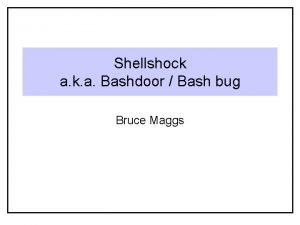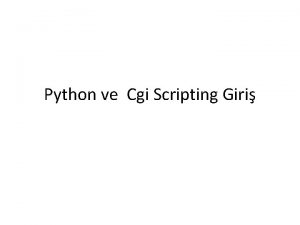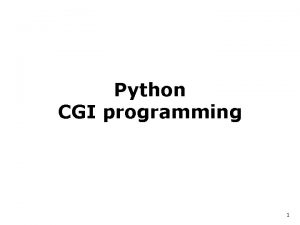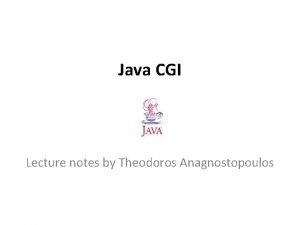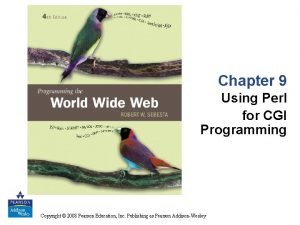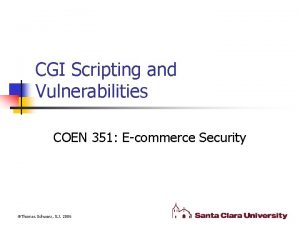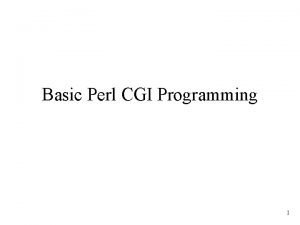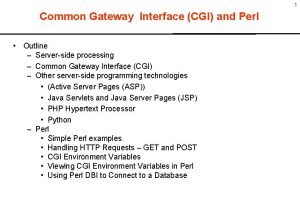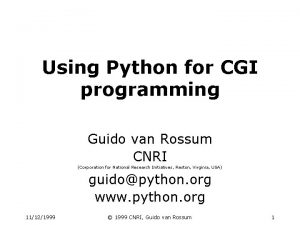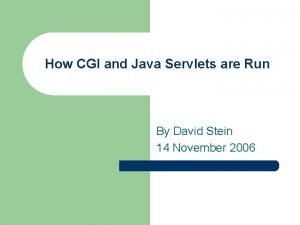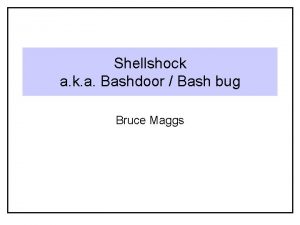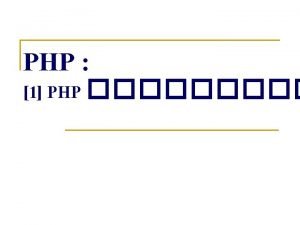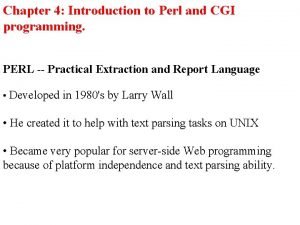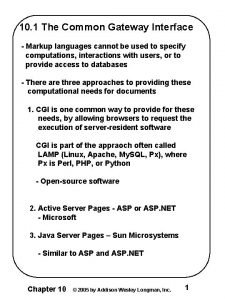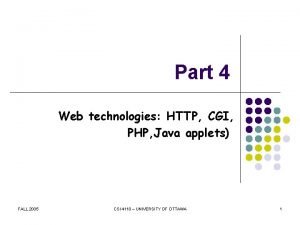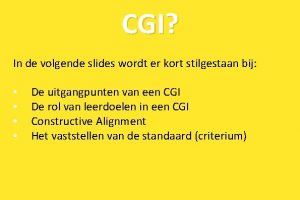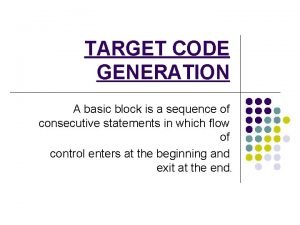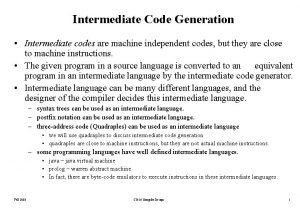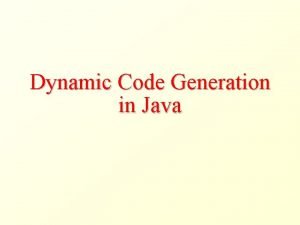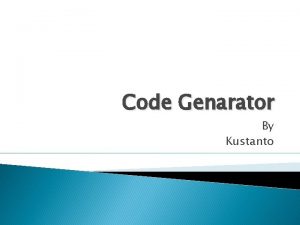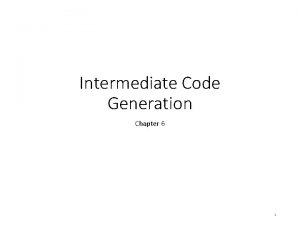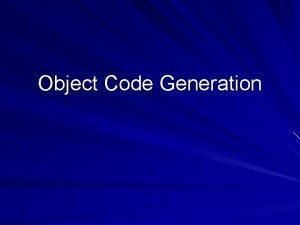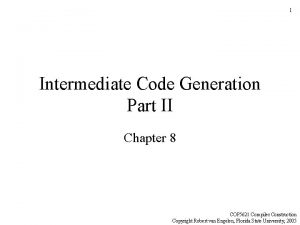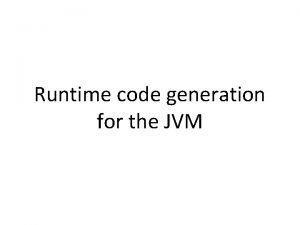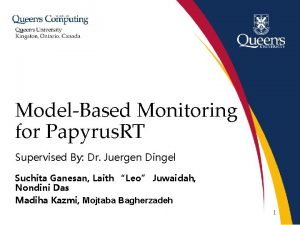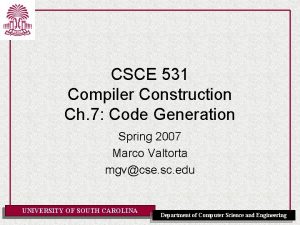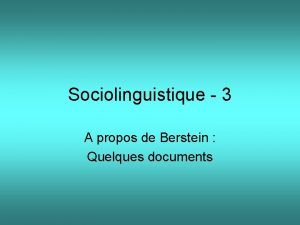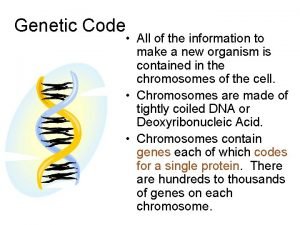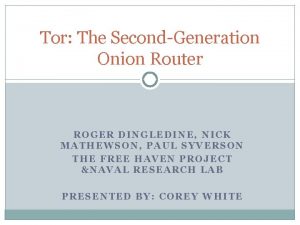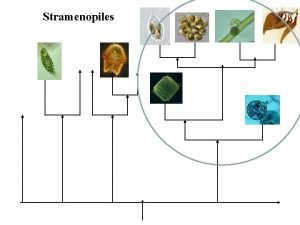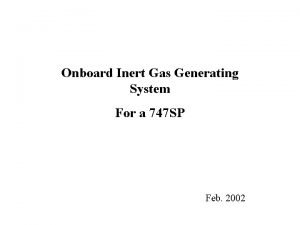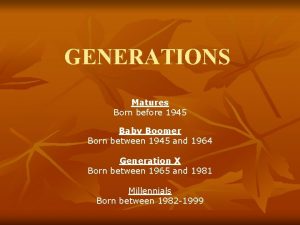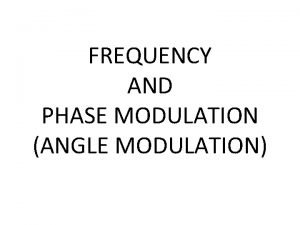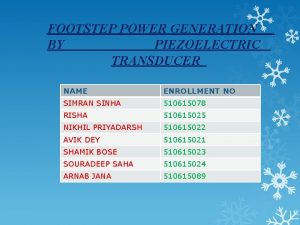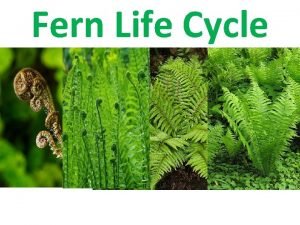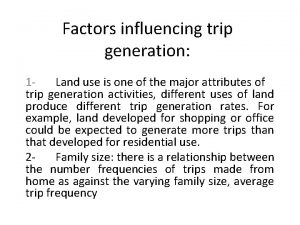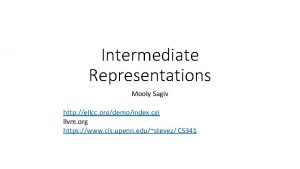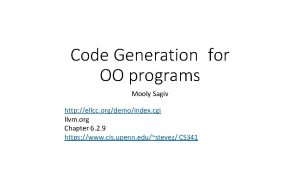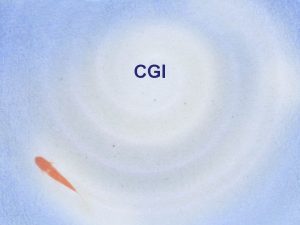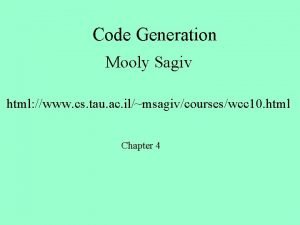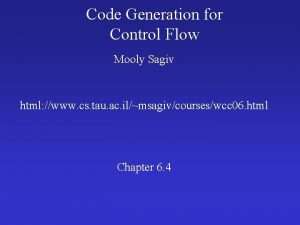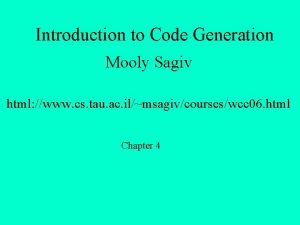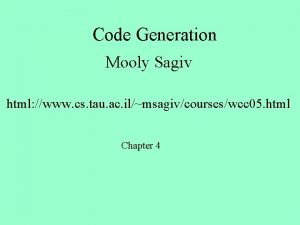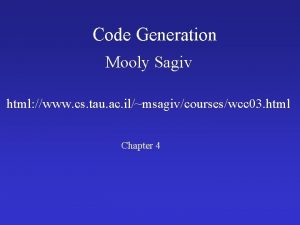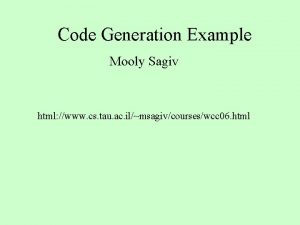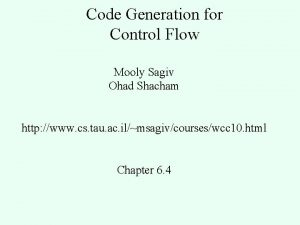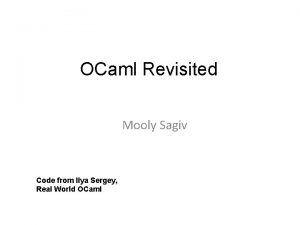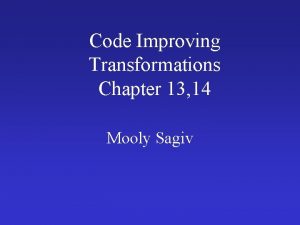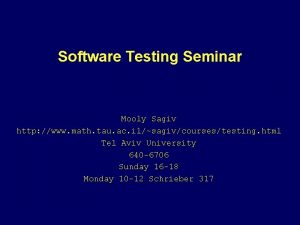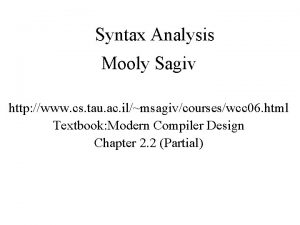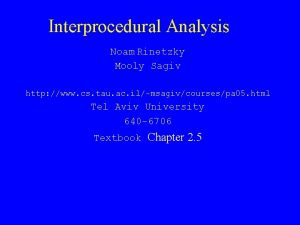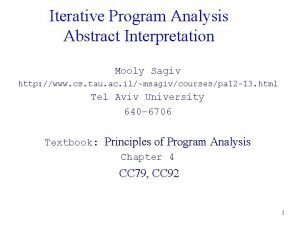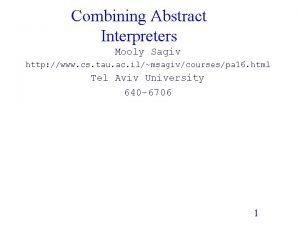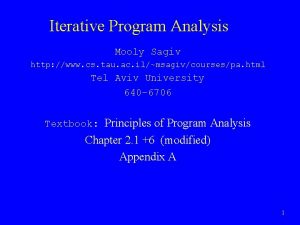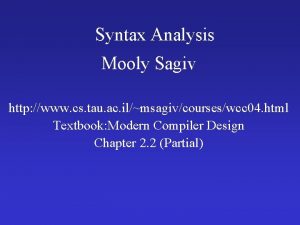Code Generation Mooly Sagiv http ellcc orgdemoindex cgi












![Coloring by Simplification [Kempe 1879] • K • the number of machine registers • Coloring by Simplification [Kempe 1879] • K • the number of machine registers •](https://slidetodoc.com/presentation_image_h2/37afd2a89fa211bec94ae35882c5acaa/image-13.jpg)
































![enter: c 1 : = r 3 M[c_loc] : = c 1 a : enter: c 1 : = r 3 M[c_loc] : = c 1 a :](https://slidetodoc.com/presentation_image_h2/37afd2a89fa211bec94ae35882c5acaa/image-46.jpg)
![enter: r 3 : = r 3 M[c_loc] : = r 3 r 1 enter: r 3 : = r 3 M[c_loc] : = r 3 r 1](https://slidetodoc.com/presentation_image_h2/37afd2a89fa211bec94ae35882c5acaa/image-47.jpg)















































- Slides: 94

Code Generation Mooly Sagiv http: //ellcc. org/demo/index. cgi llvm. org https: //www. cis. upenn. edu/~stevez/ CS 341

Outline • Recap Register Allocation • Generating LLVM for imperative programs • • • Local Variables Expressions Assignments Boolean Expressions Control Flow

Register Allocation • Map symbolic registers into physical • Chose between caller= and callee-save registers • Reuse machine registers • Avoid store/loads • Sometimes eliminate mov • Allocate the same register to source and target

A Simple Example L 0: a 0 L 0: r 1 0 L 1: b a+1 L 1: r 1 + 1 c c+b r 2 + r 1 a b*2 r 1 * 2 if c < N goto L 1 return c if r 2 < N goto L 1 return r 2 Can this be implemented in a machine with two registers? 4

Live symbolic registers • A symbolic register is live at a program point if it may be used before set on some path from this point • A symbolic register is not live (dead) at a program point if it is not used on all paths from this point

Using Liveness information • Symbolic Registers which are not live together can share the same symbolic register

Liveness in the example {c} a 0 L 0: a 0 L 1: b a+1 c c+b a b*2 if c < N goto L 1 return c {c, a} b a+1 b a + 1 {c, b} c c+b a b*2 {c, b} {c, a} if c < N goto L 1 {c} return c 7

Iteratively Computing Liveness • Start with dead variables at all program points • The return value is live • Iteratively add live variables by backward propagation • Terminate when no live variables are added

Iteratively Computing Liveness • Construct a control flow graph of instructions • Every instruction uses a set of variables and defines a set of variables • example x = y+z live. Out(q)=live. In(n) live. In(m) ) live. In(p) • use({y, z}) • def({x}) q • Liveness Equations • live. Out(exit) = {} • live. In(n) = (live. Out(n) – def(n)) use(n) • live. Out(n) = m: succ(n, m) live. In(m) • Computed iteratively from the exit node n m p

Liveness Recursive Equations use def 1 {a} 2 {b} 4 {a} {} b a+1 3 c c+b {c} {} a 0 5 a b*2 if c < N goto L 1 6 return c {} live. Out(1) =Live. In(2) Live. In(1) = (Live. Out(1) – def(1)) use(1) {a} live. Out(2) =Live. In(3) Live. In(2) = (Live. Out(2) – def(2)) use(2) {c, b} live. Out(3) =Live. In(4) Live. In(3) = (Live. Out(3) – def(3)) use(3) {b} live. Out(4) =Live. In(5) Live. In(4) = (Live. Out(4) – def(4)) use(4) {c} live. Out(5) =Live. In(6) Liv. In(2) Live. In(5) = (Live. Out(5) – def(5)) use(5) {c} live. Out(6) ={} Live. In(6) = (Live. Out(6) – def(6)) use(6) 10

Iteratively Computing Liveness live. Out(1) =Live. In(2) Live. In(1) = Live. Out(1) – {a} Node Live. In(Node) 6 {c} 2 b a+1 live. Out(2) =Live. In(3) Live. In(2) = (Live. Out(2) – {b}) {a} 5 {c} 4 {b, c} 3 c c+b live. Out(3) =Live. In(4) Live. In(3) = (Live. Out(3) – {c}) {b, c} 2 {c, a} 5 {c, a} 4 live. Out(4) =Live. In(5) Live. In(4) = (Live. Out(4) – {a}) {b} 4 {b, c} 3 {b, c} 2 {c, a} 1 {c} 1 5 a 0 a b*2 if c < N goto L 1 6 return c live. Out(5) =Live. In(6) Liv. In(2) Live. In(5) = Live. Out(5) {c} live. Out(6) ={} Live. In(6) = Live. Out(6) {c} 11

Constructing interference graphs • Compute liveness information at every instruction • Variables ‘a’ and ‘b’ interfere when there exists an instruction n: a exp and ‘b’ Live. Out[n] 12
![Coloring by Simplification Kempe 1879 K the number of machine registers Coloring by Simplification [Kempe 1879] • K • the number of machine registers •](https://slidetodoc.com/presentation_image_h2/37afd2a89fa211bec94ae35882c5acaa/image-13.jpg)
Coloring by Simplification [Kempe 1879] • K • the number of machine registers • G(V, E) • the interference graph • Consider a node v V with less than K neighbors: • Color G – v in K colors • Color v in a color different than its (colored) neighbors 13

Graph Coloring by Simplification Build: Construct the interference graph Simplify: Recursively remove nodes with less than K neighbors ; Push removed nodes into stack Potential-Spill: Spill some nodes and remove nodes Push removed nodes into stack Select: Assign actual registers (from simplify/spill stack) Actual-Spill: Spill some potential spills and repeat the process 14

Challenges • The Coloring problem is computationally hard • The number of machine registers may be small • Avoid too many MOVEs • Handle “pre-colored” nodes 15

Coalescing • MOVs can be removed if the source and the target share the same register • The source and the target of the move can be merged into a single node (unifying the sets of neighbors) • May require more registers • Conservative Coalescing • Merge nodes only if the resulting node has fewer than K neighbors with degree K (in the resulting graph) 16

Constructing interference graphs (take 2) • Compute liveness information at every instruction • Two types of edges: interfere and move • Variable ‘a’ and ‘b’ are mov if there exists an instruction n: a b • Variables ‘a’ and ‘b’ interfere when there exists an instruction n: a exp, exp ≠b and ‘b’ Live. Out[n] 17

Constrained Moves • A instruction T S is constrained • if S and T interfere • May happen after coalescing X Y /* X, Y, Z */ X Y Y Z Z • Constrained MOVs are not coalesced 18

Example of Constrained Moves if (…) { x=y; // x and y are live // move edge // no interference edge } else { x = 5; // x and y are live // x and y interfere } z = x + y // z x y z 19

Graph Coloring with Coalescing Build: Construct the interference graph Simplify: Recursively remove non MOVE nodes with less than K neighbors; Push removed nodes into stack Coalesce: Conservatively merge unconstrained MOV related nodes with fewer than K “heavy” neighbors Freeze: Give-Up Coalescing on some low-degree MOV related nodes Potential-Spill: Spill some nodes and remove nodes Push removed nodes into stack Select: Assign actual registers (from simplify/spill stack) Actual-Spill: Spill some potential spills and repeat the process 20

Spilling • Many heuristics exist • Maximal degree • Live-ranges • Number of uses in loops • The whole process need to be repeated after an actual spill 21

Pre-Colored Nodes • Some registers in the intermediate language are precolored: • correspond to real registers (stack-pointer, frame-pointer, parameters, ) • Cannot be Simplified, Coalesced, or Spilled (infinite degree) • Interfered with each other • But normal temporaries can be coalesced into pre-colored registers • Register allocation is completed when all the nodes are pre -colored 22

A Complete Example (Andrew Appel) https: //www. cs. princeton. edu/~appel/ enter: c : = r 3 a : = r 1 b : = r 2 d : = 0 e : = a r 1, r 2 caller save r 3 callee-save loop: d : = d+b e : = e-1 if e>0 goto loop r 1 : = d r 3 : = c return /* r 1, r 3 */ 23

Graph Coloring with Coalescing Build: Construct the interference graph Simplify: Recursively remove non MOVE nodes with less than K neighbors; Push removed nodes into stack Coalesce: Conservatively merge unconstrained MOV related nodes with fewer that K “heavy” neighbors Freeze: Give-Up Coalescing on some low-degree MOV related nodes Potential-Spill: Spill some nodes and remove nodes Push removed nodes into stack Select: Assign actual registers (from simplify/spill stack) Actual-Spill: Spill some potential spills and repeat the process 24

A Complete Example use{r 3} def{c} enter: c : = r 3 a : = r 1 b : = r 2 d : = 0 e : = a r 1, r 2 caller save r 3 callee-save use{r 1} def{a} use{r 2} def{b} use{} def{d} use{a} def{e} loop: d : = d+b e : = e-1 if e>0 goto loop r 1 : = d r 3 : = c return /* r 1, r 3 */ use{d, b} def{d} {c, d, e} use{e} def{e} {c, d, e} use{e} def{} {c, d} use{d} def{r 1} {r 1, c} {r 1, r 3} use{c} def{r 3} 25

A Complete Example use{r 3} def{c} enter: c : = r 3 a : = r 1 b : = r 2 d : = 0 e : = a use{r 1} def{a} use{r 2} def{b} use{} def{d} use{a} def{e} {c, d, e, b} loop: d : = d+b e : = e-1 if e>0 goto loop r 1 : = d r 3 : = c return /* r 1, r 3 */ use{d, b} def{d} {c, d, e} use{e} def{e} {c, d, e} use{e} def{} {c, d, e, b} use{d} def{r 1} {r 1, c} {r 1, r 3} use{c} def{r 3} 26

A Complete Example use{r 3} def{c} enter: c : = r 3 a : = r 1 b : = r 2 d : = 0 e : = a use{r 1} def{a} use{r 2} def{b} use{} def{d} use{a} def{e} {c, d, e, b} loop: d : = d+b e : = e-1 if e>0 goto loop r 1 : = d r 3 : = c return /* r 1, r 3 */ use{d, b} def{d} {c, d, e} use{e} def{e} {c, d, e, b} use{e} def{} {c, d, e, b} use{d} def{r 1} {r 1, c} {r 1, r 3} use{c} def{r 3} 27

A Complete Example { r 2, r 1, r 3} use{r 3} def{c} {c, r 2, r 1} enter: c : = r 3 a : = r 1 b : = r 2 d : = 0 e : = a use{r 1} def{a} {c, a, r 2} use{r 2} def{b} {c, b, a} use{} def{d} {c, d, b, a} use{a} def{e} {c, d, e, b} loop: d : = d+b e : = e-1 if e>0 goto loop r 1 : = d r 3 : = c return /* r 1, r 3 */ use{d, b} def{d} {c, d, e, b} use{e} def{e} {c, d, e, b} use{e} def{} {c, d, e, b} {r 1, r 3} use{d} def{r 1} {r 1, c} use{c} def{r 3} 28

Live Variables Results enter: c : = r 3 a : = r 1 b : = r 2 d : = 0 e : = a loop: d : = d+b e : = e-1 if e>0 goto loop r 1 : = d r 3 : = c return /* r 1, r 3 */ c : = r 3 a : = r 1 b : = r 2 d : = 0 e : = a /* r 2, r 1, r 3 */ /* c, r 2, r 1 */ /* a, c, r 2 */ /* a, c, b, d */ /* e, c, b, d */ loop: d : = d+b /* e, c, b, d */ e : = e-1 /* e, c, b, d */ if e>0 goto loop /* c, d */ r 1 : = d /* r 1, c */ r 3 : = c /* r 1, r 3 */ return /* r 1, r 3 */ 29

enter: c : = r 3 a : = r 1 b : = r 2 d : = 0 e : = a /* r 2, r 1, r 3 */ /* c, r 2, r 1 */ /* a, c, r 2 */ /* a, c, b, d */ /* e, c, b, d */ loop: d : = d+b /* e, c, b, d */ e : = e-1 /* e, c, b, d */ if e>0 goto loop /* c, d */ r 1 : = d /* r 1, c */ r 3 : = c /* r 1, r 3 */ return /* r 1, r 3 */ 30

spill priority = (uo + 10 ui)/deg enter: c : = r 3 a : = r 1 b : = r 2 d : = 0 e : = a /* r 2, r 1, r 3 */ /* c, r 2, r 1 */ /* a, c, r 2 */ /* a, c, b, d */ / * e, c, b, d */ loop: d : = d+b /* e, c, b, d */ e : = e-1 /* e, c, b, d */ if e>0 goto loop /* c, d */ r 1 : = d /* r 1, c */ r 3 : = c /* r 1, r 3 */ return /* r 1, r 3 */ use+ deg spill def priority outside within loop a 2 0 4 0. 5 b 1 1 4 2. 75 c 2 0 6 0. 33 d 2 2 4 5. 5 e 1 3 3 10. 3 31

Spill C stack c 32

Coalescing a+e stack c 33

Coalescing b+r 2 stack c 34

Coalescing ae+r 1 stack c r 1 ae and d are constrained 35

Simplifying d stack c d c 36

Pop d stack c d is assigned to r 3 37

Pop c stack c c actual spill! 38

enter: c : = r 3 a : = r 1 b : = r 2 d : = 0 e : = a /* r 2, r 1, r 3 */ /* c, r 2, r 1 */ /* a, c, r 2 */ /* a, c, b, d */ / * e, c, b, d */ enter: loop: /* r 2, r 1, r 3 */ c 1 : = r 3 /* c 1, r 2, r 1 */ M[c_loc] : = c 1 /* r 2 */ a : = r 1 /* a, r 2 */ b : = r 2 /* a, b */ d : = 0 /* a, b, d */ e : = a / * e, b, d */ d : = d+b /* e, c, b, d */ loop: e : = e-1 /* e, c, b, d */ if e>0 goto loop /* c, d */ r 1 : = d /* r 1, c */ r 3 : = c /* r 1, r 3 */ return /* r 1, r 3 */ d : = d+b /* e, b, d */ e : = e-1 /* e, b, d */ if e>0 goto loop /* d */ r 1 : = d /* r 1 */ c 2 : = M[c_loc] /* r 1, c 2 */ r 3 : = c 2 /* r 1, r 3 */ return /* r 1, r 3 */ 39

enter: /* r 2, r 1, r 3 */ c 1 : = r 3 /* c 1, r 2, r 1 */ M[c_loc] : = c 1 /* r 2 */ a : = r 1 /* a, r 2 */ b : = r 2 /* a, b */ d : = 0 /* a, b, d */ e : = a / * e, b, d */ loop: d : = d+b /* e, b, d */ e : = e-1 /* e, b, d */ if e>0 goto loop /* d */ r 1 : = d /* r 1 */ c 2 : = M[c_loc] /* r 1, c 2 */ r 3 : = c 2 /* r 1, r 3 */ return /* r 1, r 3 */ 40

Coalescing c 1+r 3; c 2+c 1 r 3 stack 41

Coalescing a+e; b+r 2 stack 42

Coalescing ae+r 1 stack d r 1 ae and d are constrained 43

Simplify d stack d d 44

Pop d stack d d a b c 1 c 2 d e r 1 r 2 r 3 r 3 r 1 45
![enter c 1 r 3 Mcloc c 1 a enter: c 1 : = r 3 M[c_loc] : = c 1 a :](https://slidetodoc.com/presentation_image_h2/37afd2a89fa211bec94ae35882c5acaa/image-46.jpg)
enter: c 1 : = r 3 M[c_loc] : = c 1 a : = r 1 b : = r 2 d : = 0 e : = a loop: d : = d+b e : = e-1 if e>0 goto loop r 1 : = d c 2 : = M[c_loc] r 3 : = c 2 return /* r 1, r 3 */ a b c 1 c 2 d e r 3 : = r 3 M[c_loc] : = r 3 r 1 : = r 1 r 2 : = r 2 r 3 : = 0 r 1 : = r 1 r 2 r 3 r 3 r 1 loop: r 3 : = r 3+r 2 r 1 : = r 1 -1 if r 1>0 goto loop r 1 : = r 3 : = M[c_loc] r 3 : = r 3 return /* r 1, r 3 */ 46
![enter r 3 r 3 Mcloc r 3 r 1 enter: r 3 : = r 3 M[c_loc] : = r 3 r 1](https://slidetodoc.com/presentation_image_h2/37afd2a89fa211bec94ae35882c5acaa/image-47.jpg)
enter: r 3 : = r 3 M[c_loc] : = r 3 r 1 : = r 1 r 2 : = r 2 r 3 : = 0 r 1 : = r 1 loop: r 3 : = r 3+r 2 r 1 : = r 1 -1 if r 1>0 goto loop r 1 : = r 3 : = M[c_loc] r 3 : = r 3 return /* r 1, r 3 */ M[c_loc] : = r 3 : = 0 loop: r 3 : = r 3+r 2 r 1 : = r 1 -1 if r 1>0 goto loop r 1 : = r 3 : = M[c_loc] return /* r 1, r 3 */ 47

Interprocedural Allocation • Allocate registers to multiple procedures • Potential saving • caller/callee save registers • Parameter passing • Return values • But may increase compilation cost • Function inline can help 48

Summary (Register Allocation) • Two Register Allocation Methods • Local of every expression tree • Simultaneous instruction selection and register allocation • Reorder computations • Optimal (under certain conditions) • Global of every function • • Applied after instruction selection Performs well for machines with many registers Can handle instruction level parallelism More symbolic names help • Simplifies the coloring problem • Missing • Interprocedural allocation 49

Generating LLVM Code

Variable Declarations • Allocate space in the stack or data • Use symbolic registers int foo() { int x; static int y=7; int z =5; x = y + z; return x; } @foo. y = interal global i 32 7, align 4 define i 32 @foo() #0 { %1 = alloca i 32, align 4 %2 = alloca i 32, align 4 store i 32 5, i 32* %2, align 4 %3 = load i 32, i 32* @foo. y, align 4 %4 = load i 32, i 32* %2, align 4 %5 = add nsw i 32 %3, %4 store i 32 %5, i 32* %1, align 4 %6 = load i 32, i 32* %1, align 4 ret i 32 %6 }

Stack Code Blocks • Programming languages provide code blocks void foo() { int x = 8 ; y=9; //1 777777684 { int x = y * y ; //2 } 777777700 { int x = y * 7 ; //3} 777777716 x = y + 1; 777777732 } 777777736 72 x 3 81 9 x 2 8 Administrative y 1 x 1 52

L-values vs. R-values • Assignment x : = exp is compiled into: • Compute the address of x • Compute the value of exp • Store the value of exp into the address of x • Generalization • R-value • Maps program expressions into values • L-value • Maps program expressions into locations • Not always defined • Java has no small L-values 53

A Simple Example int x = 5; Runtime memory x = x + 1; 17 5

A Simple Example int x = 5; Runtime memory lvalue(x)=17, rvalue(x) =5 lvalue(5)= , rvalue(5)=5 x = x + 1; 17 lvalue(x)=17, rvalue(x) =6 lvalue(5)= , rvalue(5)=5 6

Partial rules for Lvalue in C • Type of e is pointer to T • Type of e 1 is integer • lvalue(e 2) undefined { int a[100]; *(a + 5) = 8; } exp lvalue rvalue id location(id) content(location(id)) const undefined value(const) *e rvalue(e) content(rvalue(e)) &e 2 undefined lvalue(e 2) e + e 1 undefined rvalue(e)+sizeof(T)*rvalue(e 1)

Parameter passing • Pass-by-reference • Place L-value (address) in activation record • Function can assign to variable that is passed • Pass-by-value • Place R-value (contents) in activation record • Function cannot change value of caller’s variable • Reduces aliasing (alias: two names refer to same loc)

Prolog Code Generation • Store L-values of automatic variables in symbolic registers • Initialize automatic variables int foo() { int x; static int y=7; int z =5; x = y + z; return x; } @foo. y = interal global i 32 7, align 4 define i 32 @foo() #0 { %1 = alloca i 32, align 4 %2 = alloca i 32, align 4 store i 32 5, i 32* %2, align 4 %3 = load i 32, i 32* @foo. y, align 4 %4 = load i 32, i 32* %2, align 4 %5 = add nsw i 32 %3, %4 store i 32 %5, i 32* %1, align 4 %6 = load i 32, i 32* %1, align 4 ret i 32 %6 }

Generating Code to Compute R-values • Reclusively traverse the tree • Load R-values of variables and constants into new symbolic register • Store each subtree into a new symbolic registers

Pseudocode R -Value register rvalue(e: expression) { new: register = new. Register() switch e { case number(n: integer): { emit(%new = load i 32 n, align 4) } case local. Variable(v: symbol): { r: register = register. Of(v) emit(%new= load i 32* r, align 4) } case e 1: expression PLUS e 2: expression: { l: register = rvalue(e 1) // Generate code for lhs into l r: register = rvalue(e 2) // Generate code for rhs into r emit(%new = add nsw i 32 l, r) } return new; }

Simple Example int foo() { int x; static int y=7; int z =5; x = y + z; return x; } @foo. y = interal global i 32 7, align 4 define i 32 @foo() #0 { %1 = alloca i 32, align 4 %2 = alloca i 32, align 4 store i 32 5, i 32* %2, align 4 %3 = load i 32, i 32* @foo. y, align 4 %4 = load i 32, i 32* %2, align 4 %5 = add nsw i 32 %3, %4 store i 32 %5, i 32* %1, align 4 %6 = load i 32, i 32* %1, align 4 ret i 32 %6 }

Example Compilation + %5=add nsw i 32 %1, %3 5 + %4=add nsw i 32 %2, %3 %1=load i 32 5, align 4 x %2=load i 32*, r_x, align 4 7 %3=load i 32 7, align 4

Generating Code to Compute L-values • Reclusively traverse the tree • Load L-values into new symbolic register • Store each subtree into a new symbolic registers

Pseudocode L-Value (partial) register lvalue(e: expression) { switch e: { case number(n: integer): { exit(“internal error no L-value”); } case local. Variable(v: symbol): { r: register = register. Of(v) return r ; } case deref(de: expression): { return ? }

Pseudocode L-Value (partial) register lvalue(e: expression) { switch e: { case number(n: integer): { exit(“internal error no L-value”); } case local. Variable(v: symbol): { r: register = register. Of(v) return r ; } case deref(de: expression): { return rvalue(de) } …. }

Assignments • Computer L value of LHS into a register • Compute R value of RHS into a register • Store result assign(le: expression, re: expression) { l: register = lvalue(le); r: register = rvalue(re); emit(store i 32 r, i 32* l, align 4); }

Simple Example int foo() { int x; static int y=7; int z =5; x = y + z; return x; } rvalue(x+y) @foo. y = interal global i 32 7, align 4 define i 32 @foo() #0 { %1 = alloca i 32, align 4 %2 = alloca i 32, align 4 store i 32 5, i 32* %2, align 4 %3 = load i 32, i 32* @foo. y, align 4 %4 = load i 32, i 32* %2, align 4 %5 = add nsw i 32 %3, %4 store i 32 %5, i 32* %1, align 4 %6 = load i 32, i 32* %1, align 4 ret i 32 %6 }

Code Generation for Control Flow Chapter 6. 4

Motivating Example void foo(int x) { if (!(!(x >7) || (x <=9))) { x = 5; } } define void @foo(i 32) #0 { %2 = alloca i 32, align 4 store i 32 %0, i 32* %2, align 4 %3 = load i 32, i 32* %2, align 4 %4 = icmp sgt i 32 %3, 7 br i 1 %4, label %5, label %9 ; <label>: 5: ; preds = %1 %6 = load i 32, i 32* %2, align 4 %7 = icmp sle i 32 %6, 9 br i 1 %7, label %9, label %8 ; <label>: 8: ; preds = %5 store i 32 5, i 32* %2, align 4 br label %9 ; <label>: 9: ; preds = %8, %5, %1 ret void }

Boolean Expressions • In principle behave like arithmetic expressions • But are treated specially • • Different machine instructions Used in control flow instructions Shortcut computations Negations can be performed at compile-time if (a < b) goto l Code for a < b yielding a condition value Conversion condition value into Boolean Conversion from Boolean in condition value Jump to l on condition value 70

Location vs. Value Computation • Option 1: The value of expression is stored in a designated location or register • Option 2: If e=N to v then the code will reach a location l • If the value of e is true then the program will reach lt • If the value of e is true then the program will reach lf • used for Booleans

Shortcut computations • Languages such as C define shortcut computation rules for Boolean • Incorrect translation of e 1 && e 2 Code to compute e 1 in loc 1 Code to compute e 2 in loc 2 Code for && operator on loc 1 and loc 2 72

Location Computation • The result of a Boolean expression is pair of locations in the generated code • The true location corresponds to the target instruction when the condition holds • The false location corresponds to the target instruction when the condition does not hold 73

Code for e 1 && e 2 Code for e 1 into r 1 if r 1 then goto L 11 br L 12 true-e 1 false-e 1 L 11: Code for e 2 into r 2 if r 2 then goto L 21 br L 22 L 21: L 12: L 22: true-e 2 false-e 2 true-e 1&&e 2 false-e 1&&e 2 74

Code for Booleans (Location Computation) • Top-Down tree traversal • Generate code sequences instructions • Jump to a designated ‘true’ label when the Boolean expression evaluates to 1 • Jump to a designated ‘false’ label when the Boolean expression evaluates to 0 • The true and the false labels are passed as parameters 75

Example if ((a==0) && (b > 5)) x = ((7 * a) + b) if && == a : = x > 0 b 5 + * 7 b a 76

if Lt Lf && No label Lf Lt == Lf x > %3, %4 %6= icmp sgt %3= icmp eq %1, %2 Lf: : = Lt: + * b br i 1 %6 Lf br i 1 %3 Lf 7 a Code for : = a %1= load ‘a’ 0 %2= load 0 b 5 %4=load ‘b’ %5=load 5 77

Location Computation for Booleans void location_value(e: expression, t: label, f: label) { switch e { case e 1: expression GT e 2: expression: { l: register = rvalue(e 1) // Generate code for lhs into l r: register = rvalue(e 2) // Generate code for rhs into r if (t != no-label) { n: register = new. Register() emit(n= icmp gt i 32 l, r); emit(br i 1, n, t) if (f != no-label) { emit(br f) } } else if (f != no-label) { emit(icmp le i 32 l, r, t) } } // similar for other relational operators case e 1: expression Lazy. And e 2: expression: { } case e 1: expression Lazy. Or e 2: expression: {} case not e 1: expression: {} 78

Location Computation for Booleans(2) void location_value(e: expression, t: label, f: label) { switch e { … case e 1: expression Lazy. And e 2: expression: { location. Value(e 1, no-label, f) location. Value(e 2, t, f) } case e 1: expression Lazy. Or e 2: expression: { location. Value(e 1, t, no-label) location. Value(e 2, t, f) } case not e 1: expression: location. Value(e 1, f, t) 79

Code generation for IF Allocate two new labels Lf, Lend if Generate code for Boolean(left, No label Lf) Boolean expression Lend: true sequence false sequence Code for Boolean with jumps to Lf Code for true sequence false sequence GOTO Lend Lf: 80

Code generation for IF (no-else) Allocate new label Lend if Generate code for Boolean(left, no-label, Lend) Boolean expression Code for Boolean with jumps to Lend: true sequence Code for true sequence 81

Coercions into value computations : = Generate new label Lf %1= load 0; Generate code for Boolean(right, no-label, Lf) x a>b %2= load ‘a’ %3 =icmp leq %2, ‘b’ br i 1 %3, Lf %1=load 1 Lf: store i 32 %1 32* ‘x’ 82

Effects on performance • Number of executed instructions • Unconditional vs. conditional branches • Instruction cache • Branch prediction • Target look-ahead 83

Code for case statements • Three possibilities • Sequence of IFs • O(n) comparisons • Jump table • O(1) comparisons • Balanced binary tree • O(log n) comparisons • Performance depends on n • Need to handle runtime errors 84

Simple Translation tmp_case_value : = case expression; IF tmp_case_value = l 1 THEN GOTO label_1; IF tmp_case_value = l 2 THEN GOTO label_2; … IF tmp_case_value = ln THEN GOTO label_n; GOTO label_else; // or insert the code at label else label 1: Code for statement sequence 1 GOTO label_next; label 2: Code for statement sequence 2 GOTO label_next; … label n: Code for statement sequencen GOTO label_next; label else: Code for else-statement sequence 85

Balanced trees • The jump table may be inefficient • Space consumption • Cache performance • Organize the case labels in a balanced tree • Left subtrees smaller labels • Right subtrees larger labels • Code generated for node_k label_k: IF tmp_case_value < lk THEN GOTO label of left branch ; IF tmp_case_value >lk THEN GOTO label of right branch; code for statement sequence; GOTO label_next; 86

Repetition Statements (loops) • Similar to IFs • Preserve language semantics • Performance can be affected by different instruction orderings • Some work can be shifted to compile-time • Loop invariant • Strength reduction • Loop unrolling 87

while statements Generate new labels test_label, Lend test_label: while Generate code for Boolean(left, no-label, Lend) GOTO test_label; Lend: statement Boolean expression Sequence Code for Boolean with jumps to Lend statement sequence 88

while statements(2) Generate labels test_label, Ls GOTO test_label: Ls: test_label: while Generate code for Boolean(left, Ls, no-label) Code for statement sequence Boolean expression statement Sequence Code for Boolean with jumps to LS 89

Simple-minded translation FOR i in lower bound. . upper bound DO statement sequence END for i : = lower_bound; tmp_ub : = upper_bound; WHILE i <= tmp_ub DO code for statement sequence i : = i + 1; END WHILE 90

Correct Translation FOR i in lower bound. . upper bound DO statement sequence END for i : = lower_bound; tmp_ub : = upper_bound; IF i >tmp_ub THEN GOTO end_label; loop_label: code for statement sequence if (i==tmp_ub) GOTO end_label; i : = i + 1; GOTO loop_label; end_label: 91

Tricky question for (exp 1; exp 2; exp 3) { body; } exp 1; while (exp 2) { body; exp 3; } 92

Summary • Handling control flow statements is usually simple • Complicated aspects • Routine invocation • Non local gotos • Runtime profiling can help 93

Summary Code Generation • Preserve the semantics with local transformations into intermediate language • Perform computations at compile-time • Much more can be done • Every subtree is converted into an equivalent instruction sequences • Uses unbounded registers and labels to simplify matters
 Mooly sagiv
Mooly sagiv First generation antipsychotics vs second
First generation antipsychotics vs second You're good and your mercy is forever
You're good and your mercy is forever Busceral
Busceral Printenv.pl exploit
Printenv.pl exploit Python cgi
Python cgi Python cgi programming examples
Python cgi programming examples Pengganti iggi
Pengganti iggi Cgi in java
Cgi in java Cgi-mp
Cgi-mp Cgi linkage in perl
Cgi linkage in perl Cgi security
Cgi security Cgi ecommerce
Cgi ecommerce Html program
Html program Advantages and disadvantages of common gateway interface
Advantages and disadvantages of common gateway interface Nodejs cgi
Nodejs cgi Cgi programming on the world wide web
Cgi programming on the world wide web Python cgi tutorial
Python cgi tutorial Cgi in java
Cgi in java Madeleine jacobs
Madeleine jacobs Apmsetup7
Apmsetup7 Ncbi
Ncbi Printenv.pl exploit
Printenv.pl exploit Cgi language
Cgi language Cgi
Cgi Cgi
Cgi Introduction to cgi
Introduction to cgi Chang cgi
Chang cgi Cgi linkage in perl
Cgi linkage in perl Perl tutorial javatpoint
Perl tutorial javatpoint Cgi concepts in web technology
Cgi concepts in web technology Criterium gericht interview
Criterium gericht interview Target code generation
Target code generation What is intermediate code generation
What is intermediate code generation Java runtime code generation
Java runtime code generation Input dan output pada tahap code generator
Input dan output pada tahap code generator Types and declarations in intermediate code generation
Types and declarations in intermediate code generation Object code generation
Object code generation Backpatching in intermediate code generation
Backpatching in intermediate code generation Java runtime code generation
Java runtime code generation Papyrus rt
Papyrus rt Compiler code generation
Compiler code generation Http //mbs.meb.gov.tr/ http //www.alantercihleri.com
Http //mbs.meb.gov.tr/ http //www.alantercihleri.com Http //siat.ung.ac.id atau http //pmb.ung.ac.id
Http //siat.ung.ac.id atau http //pmb.ung.ac.id Www . menti.com
Www . menti.com Code élaboré code restreint
Code élaboré code restreint Managed and unmanaged code
Managed and unmanaged code Object code vs assembly code
Object code vs assembly code Difference between source code and machine code
Difference between source code and machine code Code switching and code mixing
Code switching and code mixing Order of bases in dna
Order of bases in dna Generational differences chart
Generational differences chart First generation consoles
First generation consoles 2008 generation called
2008 generation called Trip generation
Trip generation Tor: the second-generation onion router
Tor: the second-generation onion router Third generation rights
Third generation rights Generation y characteristics
Generation y characteristics Why is the lost generation called that
Why is the lost generation called that Steps in mbo
Steps in mbo The lost generation years
The lost generation years The lost generation years
The lost generation years The lost generation facts
The lost generation facts Five generation of computer
Five generation of computer Five generations of computer
Five generations of computer 1944 generation name
1944 generation name Ectocarpus
Ectocarpus Shinjinrui generation
Shinjinrui generation Starburst method in computer graphics
Starburst method in computer graphics New product lines
New product lines Physical and chemical changes generation genius
Physical and chemical changes generation genius Generation y characteristics
Generation y characteristics Personalised customer communication
Personalised customer communication Third generation cephalosporin
Third generation cephalosporin Palo alto traps gartner
Palo alto traps gartner Aircraft onboard inert gas generation system
Aircraft onboard inert gas generation system Global next generation wireless communication market
Global next generation wireless communication market Nclex clinical judgement model
Nclex clinical judgement model Current generation name
Current generation name Næste generation digital post
Næste generation digital post Birthdates
Birthdates Next generation soc
Next generation soc The gordon method
The gordon method Green generation science olympiad
Green generation science olympiad Second generation of computer
Second generation of computer Third generation computers advantages disadvantages
Third generation computers advantages disadvantages Matures generation
Matures generation Jump street generations
Jump street generations Generation time
Generation time Find generation gap letuscrack
Find generation gap letuscrack What is concept generation
What is concept generation Armstrong method of fm generation
Armstrong method of fm generation Footstep power generation using piezoelectric sensor
Footstep power generation using piezoelectric sensor Fern alternation of generations
Fern alternation of generations Factors influencing trip production
Factors influencing trip production




